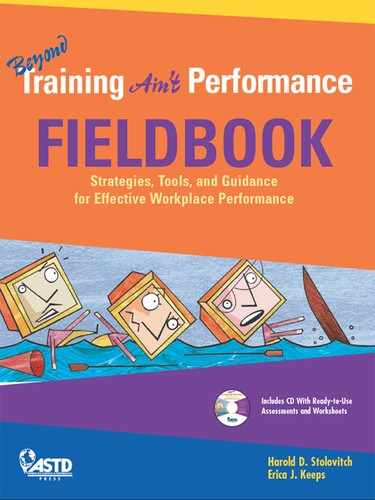Appendix B
Structured On-the-Job Training in Developing Nations
Structured on-the-job training (SOJT), adapted to a developing-nation environment, can improve significantly the performance capability of workers, and do so at low cost.
Globalization and competition in products and services have created enormous pressures to increase productivity. Developed nations have risen to the challenge. The same is not true for the developing world where the context of poverty does not permit similar investment in productivity to enable workers to compete internationally. Within developing nations a rich source of capital exists—human capability. The problem is how to organize and exploit this potential source of wealth.
The project reported here examined the opportunity for and appropriateness of SOJT in developing nations and describes a pilot effort in one African nation, Cameroon.
SOJT is a systematically planned process for designing and carrying out training. Learning takes place at the work site. Experienced workers serve as trainers and provide specific feedback on task execution. There are detailed training plans. The entire effort is integrated and orderly. It is a complete, unified system.
Implementing SOJT in Cameroon
The annual per capita income in Cameroon is US$764, which makes it one of the poorest nations. Cameroon is typical of many developing nations: high rates of poverty and unemployment; large foreign ownership; low productivity.
Adapting SOJT to the culture of Cameroon demands analyzing the technical capabilities of potential SOJT trainers, adopting teaching strategies that fit their backgrounds, exploiting cultural values and practices that enhance the SOJT experience, and verifying linguistic/ethnic compatibility.
The adapted SOJT model was tested to answer three questions: Is it effective in building performance capabilities of workers, compared with the usual training approach? Is it cost and time efficient, compared with the usual practices? Do management and employees have favorable attitudes toward SOJT, compared with the usual practices?
A controlled study compared SOJT to traditional training center (TC) preparation. The TC group did not gain in speed from pretest to posttest, despite six weeks of training (see Table A-1).
Table A-1: Pretest and Posttest Trial Times of All Tasks
| Group | Pretest | Posttest |
| SOJT group | Mean: 27 min. 30 sec. Range: 25-30 min. |
Mean: 15 min. 40 sec. Range 14-17 min. |
| Control group | Mean: 27 min. 30 sec. Range: 25-30 min. |
Mean: 27 min. 15 sec. Range: 25-30 min. |
Table A-2 compares costs of the two training approaches. The SOJT cost 25 percent less than did the TC training.
Table A-2: Training Costs in Cameroon Francs
| Item | SOJT Cost | Posttest |
| Trainer salary | 0* | 680,000 |
| Bonus for training | 400,000* | 0 |
| Trainee salaries | 600,000** | 720,000 |
| Development of training | 100,000 | 60,000 |
| Total Cost | 1,100,000 | 1,460,000 |
* SOJT trainers continued their regular jobs but received training bonuses. Training Center trainers were fully dedicated to training.
** SOJT trainees trained 15 days; control group trained 30 days. SOJT trainees worked, and so had higher salaries. $600,000 and $720,000 are based on 12 trainees each.
Table A-3 displays the results of a Likert scale type instrument used to determine trainee and trainer attitudes toward the SOJT. All recommended that the company adopt this training approach.
General Conclusions from the Project Trial
SOJT demonstrated its effectiveness, efficiency, lower cost, and high satisfaction ratings. The projected organizational benefits (ROI) are a shortened learning curve, improved worker efficiency, and lowered incident rates (for example, damages, time/cost of clean up, lost productivity). Based on the 43 percent better performance of SOJT subjects, the immediate daily benefit was calculated at 46,440cfa in savings. Add in decreased incidents (no SOJT incidents; one control group incident valued at 27,000cfa). Extrapolating over a year, a 3,000,000cfa investment to train 36 workers could yield a 33,000,000cfa savings (1000 percent ROI).
Table A-3: SOJT Satisfaction Scores*
| Group | Instructor Scores | Trainee Scores |
| SOJT procedure | 100 | 100 |
| SOJT structure | 100 | 95 |
| SOJT use of time | 95 | 98 |
| SOJT relevance of content, method | 81 | 81 |
| Overall Satisfaction | 94** | 89 |
* Maximum score = 100.
** Interviewed instructors expressed great satisfaction with bonuses and increased status as SOJT instructors.
A final note on lack of improved TC group performance. The control group spent considerable time attending classroom lectures. There was little practice. Equipment was inadequate and obsolete. Practice space was different from the work site.
Summary and Conclusions
SOJT appears to be a “natural” solution for developing countries. It is relatively inexpensive, does not require specialized expertise to create and implement, and has demonstrated very high return in terms of learning transfer and productivity payoff. Solutions such as SOJT—low cost and high yield—offer developing nations an effective means for meeting global marketplace competition.
